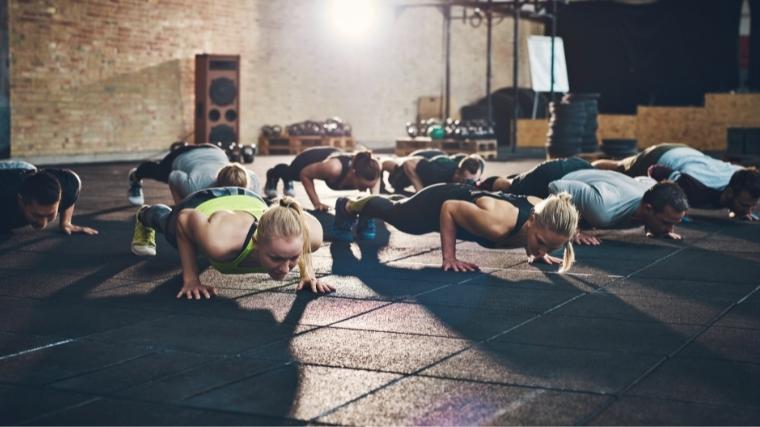http://www.marksdailyapple.com/
 Coffee, collagen, and chocolate? That’s three of our favorite things in one recipe!
Coffee, collagen, and chocolate? That’s three of our favorite things in one recipe!
While this chocolate bomb recipe might sound too good to be true, you can make this decadent coffee upgrade at home using your collagen coffee creamer from Primal Kitchen. Delight brunch guests or add a little elegance to a weekday brew with Collagen Coffee Chocolate Bombs. All you need is a few ingredients and a hot chocolate bomb mold.
Made with tempered chocolate, these “bombs” melt into hot coffee and infuse your cup with velvety, rich flavor… plus, all the collagen protein benefits from a scoop of Collagen Fuel®. Add a little elegance to your caffeine fix with this crave-worthy coffee bomb recipe!
What Is a Chocolate Bomb?
A chocolate bomb is a hollow orb made of tempered chocolate and filled with a tasty surprise—in this case, Collagen Fuel! When you drop it in hot coffee, the chocolate melts, releasing the delicious contents. From there, you can stir or use a frother or immersion blender to mix it all together. Voila, your ordinary coffee is now a deluxe coffee beverage worth bragging about!
Collagen Chocolate Bomb Recipe
Makes: 4 collagen coffee bombs

Ingredients
- 200g 85% chocolate bar (see notes for types of chocolate)
- 1/4 cup coconut milk powder
- 4 scoops Primal Kitchen Vanilla, Hazelnut or Chocolate Collagen Fuel
- 24-32 oz. of your favorite coffee
Optional additions:
- Whipped coconut cream
- Vanilla extract or powder
- Milk of choice
- Liquid stevia or monk fruit
Directions
Step 1: How to Temper Chocolate
Start by chopping your chocolate. To temper using a double boiler:
- Fill a pot with a few inches of water and place it on your stovetop over medium heat.
- Place a heat-safe bowl on top of the pot. It should be a little bigger than the pot, and the bottom of the bowl should sit nicely inside the top of the pot. Pour about 2/3 of your chopped chocolate into the pot.
- Use a spatula to stir the chocolate as it melts in the bowl. When the chocolate is nearly melted, use a food thermometer to test the temperature of the chocolate. When the melted chocolate reaches 115 degrees Fahrenheit (46 degrees Celsius), quickly remove the bowl from the heat.
- Add the remaining chocolate to the bowl a little at a time, stirring continuously to promote the rest of the chocolate melting. This will also help cool down the melted chocolate slightly.
- Once all of the chocolate has been added and the temperature of the melted chocolate reaches 80 to 82 degrees Fahrenheit (26 to 28 Celsius), place the bowl back on the pot.
- Stir until the melted chocolate reaches 88 to 89 degrees Fahrenheit (31 to 32 Celsius), then quickly remove it from the heat again. Now your chocolate is tempered and ready to use!

Step 2: Make Your Coffee Bombs in a Hot Chocolate Bomb Mold
I recommend using a 2-inch or 2.5-inch silicone mold for the coffee bombs.
Use a silicone brush to brush the chocolate all over the insides of each of the round molds. This recipe will make 4 or 5 coffee bombs depending on the size of the mold you use and how much chocolate you use in each mold, so you will need to “paint” the insides of 8 to 10 molds total. I’d recommend starting with 8. You can always make an additional one if you have extra chocolate.
Once you have made your first chocolate layer, place the mold(s) in the fridge for 5 to 10 minutes to harden.

Remove the molds from the fridge and repeat the process of brushing the chocolate inside the molds, really focusing on building up the chocolate near the rims. Place the molds back in the fridge.
At this point, you can attempt to remove the chocolate from the molds, or paint the chocolate in the molds a third time. I’d recommend 3 times total to make sure your chocolate is thick enough and stays intact. Refrigerate one last time for about 15 minutes.
Once chilled and set, carefully remove each of the round halves from the molds.
Step 3: Fill the Coffee Bombs
In a small bowl, combine the coconut milk powder and collagen powder. Scoop the mixture into 4 (or 5, if you made 10) of the chocolate halves.

Brush a little melted chocolate on the outside rim of one empty chocolate half, then carefully press it on top of one of the filled halves to create a sphere. If you’d like, you can brush some chocolate around the outside of where the rims joined and roll it in a little collagen powder or coconut milk powder, as shown in the picture below.

Repeat with the remaining chocolate. Store the collagen bombs in the fridge.
Step 4: Enjoy a Collagen Coffee Chocolate Bomb!
Brew your favorite coffee. Pour a little in a mug and then add the collagen coffee bomb. Top with more coffee until the chocolate sphere melts and the contents come out. Use a little immersion blender or frother to blend everything up.
Optionally, add your favorite milk to the coffee and/or top with whipped cream or coconut cream. Enjoy immediately.

Notes:
- I recommend using a chocolate bar rather than chocolate chips for this recipe. The chopped bar will melt better and have more success being tempered. I used a very dark chocolate bar. Using a low-carb chocolate bar (e.g., Lily’s) would probably work as well.
- If you can tolerate dairy, feel free to use regular milk powder instead of coconut milk powder.
Learn more about collagen protein benefits:
- The Definitive Guide to Collagen
- Collagen Peptides FAQ: Answering 20 Questions about Collagen Supplements
- 20 More Questions about the Benefits of Collagen Supplements

Collagen Coffee Chocolate Bomb Recipe
 Yield: 4 chocolate bombs
Yield: 4 chocolate bombs
Description
These chocolate “bombs” melt into hot coffee and infuse your cup with velvety, rich flavor… plus, all the collagen protein benefits from a scoop of Primal Kitchen Collagen Fuel®.
Ingredients
200g 85% chocolate bar (see notes for types of chocolate)
1/4 cup coconut milk powder
4 scoops Primal Kitchen Vanilla, Hazelnut or Chocolate Collagen Fuel
24–32 oz. of your favorite coffee
Instructions
Step 1: How to Temper Chocolate
Start by chopping your chocolate. To temper using a double boiler:
- Fill a pot with a few inches of water and place it on your stovetop over medium heat.
- Place a heat-safe bowl on top of the pot. It should be a little bigger than the pot, and the bottom of the bowl should sit nicely inside the top of the pot. Pour about 2/3 of your chopped chocolate into the pot.
- Use a spatula to stir the chocolate as it melts in the bowl. When the chocolate is nearly melted, use a food thermometer to test the temperature of the chocolate. When the melted chocolate reaches 115 degrees Fahrenheit (46 degrees Celsius), quickly remove the bowl from the heat.
- Add the remaining chocolate to the bowl a little at a time, stirring continuously to promote the rest of the chocolate melting. This will also help cool down the melted chocolate slightly.
- Once all of the chocolate has been added and the temperature of the melted chocolate reaches 80 to 82 degrees Fahrenheit (26 to 28 Celsius), place the bowl back on the pot.
- Stir until the melted chocolate reaches 88 to 89 degrees Fahrenheit (31 to 32 Celsius), then quickly remove it from the heat again. Now your chocolate is tempered and ready to use!
Step 2: Make Your Coffee Bombs in a Hot Chocolate Bomb Mold
We recommend using a 2-inch or 2.5-inch silicone mold for the coffee bombs.
Use a silicone brush to brush the chocolate all over the insides of each of the round molds. This recipe will make 4 or 5 coffee bombs depending on the size of the mold you use and how much chocolate you use in each mold, so you will need to “paint” the insides of 8 to 10 molds total. I’d recommend starting with 8. You can always make an additional one if you have extra chocolate.
Once you have made your first chocolate layer, place the mold(s) in the fridge for 5 to 10 minutes to harden.
Remove the molds from the fridge and repeat the process of brushing the chocolate inside the molds, really focusing on building up the chocolate near the rims. Place the molds back in the fridge.
At this point, you can attempt to remove the chocolate from the molds, or paint the chocolate in the molds a third time. I’d recommend 3 times total to make sure your chocolate is thick enough and stays intact. Refrigerate one last time for about 15 minutes.
Once chilled and set, carefully remove each of the round halves from the molds.
Step 3: Fill the Coffee Bombs
In a small bowl, combine the coconut milk powder and collagen powder. Scoop the mixture into 4 (or 5, if you made 10) of the chocolate halves.
Brush a little melted chocolate on the outside rim of one empty chocolate half, then carefully press it on top of one of the filled halves to create a sphere. If you’d like, you can brush some chocolate around the outside of where the rims joined and roll it in a little collagen powder or coconut milk powder.
Repeat with the remaining chocolate. Store the collagen bombs in the fridge.
Step 4: Enjoy a Collagen Coffee Chocolate Bomb!
Brew your favorite coffee. Pour a little in a mug and then add the collagen coffee bomb. Top with more coffee until the chocolate sphere melts and the contents come out. Use a little immersion blender or frother to blend everything up.
Optionally, add your favorite milk to the coffee and/or top with whipped cream or coconut cream. Enjoy immediately.
Notes
We recommend using a chocolate bar rather than chocolate chips for this recipe. The chopped bar will melt better and have more success being tempered. We used a very dark chocolate bar. Using a low-carb chocolate bar (e.g., Lily’s) would probably work as well.
If you can tolerate dairy, feel free to use regular milk powder instead of coconut milk powder.
Nutrition
- Serving Size: 1 chocolate bomb
- Calories: 213
- Sugar: 5.5g
- Sodium: 247g
- Fat: 11g
- Saturated Fat: 6g
- Carbohydrates: 29g
- Fiber: 8g
- Protein: 3g
- Cholesterol: 5mg
- Net Carbs: 21g
Keywords: Coffee, Collagen
The post Collagen Coffee Chocolate Bomb Recipe appeared first on Mark’s Daily Apple.






 Composting is one of those things that everyone agrees is good. There are literally no downsides, only benefits.
Composting is one of those things that everyone agrees is good. There are literally no downsides, only benefits.


 Keeping on our theme this week of minimizing food waste, today we’re going to talk about seasonal eating and getting the most out of the winter vegetables you’ll find at your farmer’s market and grocery store this time of year.
Keeping on our theme this week of minimizing food waste, today we’re going to talk about seasonal eating and getting the most out of the winter vegetables you’ll find at your farmer’s market and grocery store this time of year.
 The week of Feb 21, 2022, Primal Kitchen is featuring ways to cut down on food waste. Find food waste facts, waste reduction tips, exclusive recipes, and resources from the Farmlink Project by signing up
The week of Feb 21, 2022, Primal Kitchen is featuring ways to cut down on food waste. Find food waste facts, waste reduction tips, exclusive recipes, and resources from the Farmlink Project by signing up 

 Last week, I discussed winter survival tips and gear. That’s what most people mean when they talk about survival situations: staying alive in harsh snowy conditions. But there’s also summer survival. What do you do against the heat? If winter survival is all about maintaining body heat, keeping metabolic rate high, increasing both true temperature and the “feeling” of being warm, what is warm weather survival about?
Last week, I discussed winter survival tips and gear. That’s what most people mean when they talk about survival situations: staying alive in harsh snowy conditions. But there’s also summer survival. What do you do against the heat? If winter survival is all about maintaining body heat, keeping metabolic rate high, increasing both true temperature and the “feeling” of being warm, what is warm weather survival about?

 For now classes are 6pm and 640pm at 2840 Wildwood st in the Boise Cloggers studio.
Book your class NOW!
click this ==>
For now classes are 6pm and 640pm at 2840 Wildwood st in the Boise Cloggers studio.
Book your class NOW!
click this ==>








